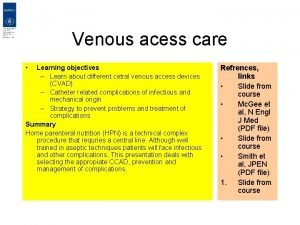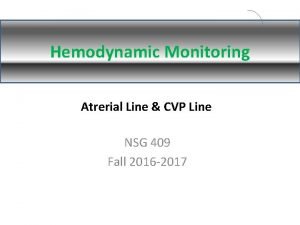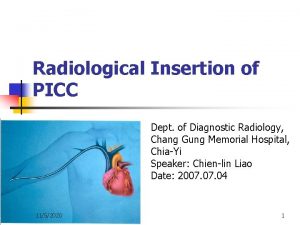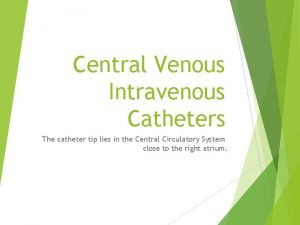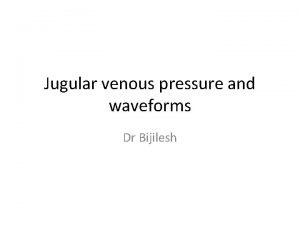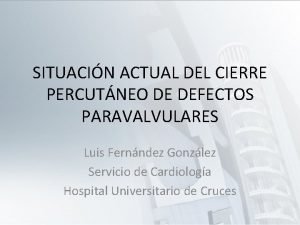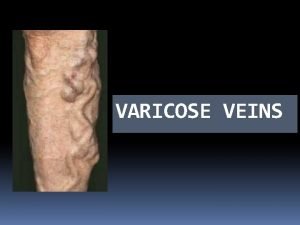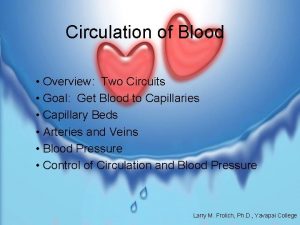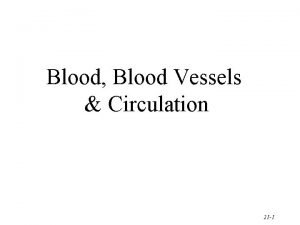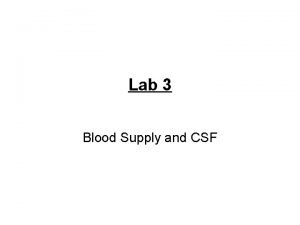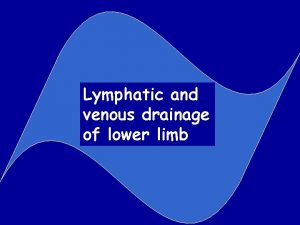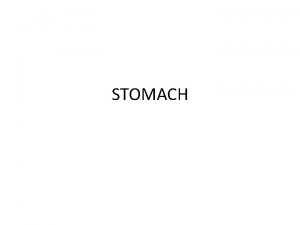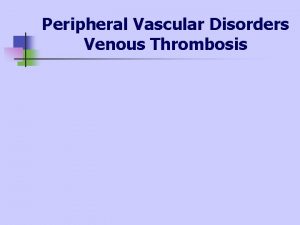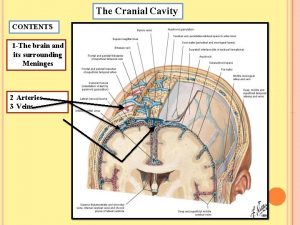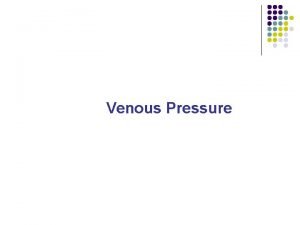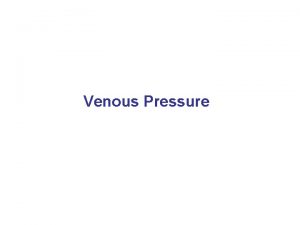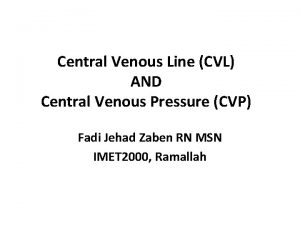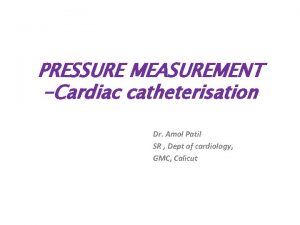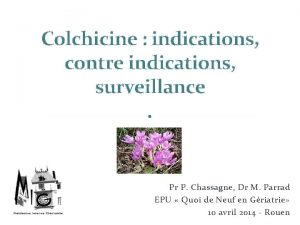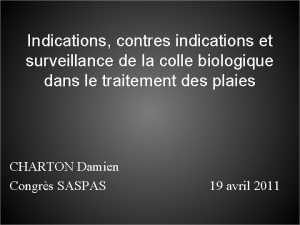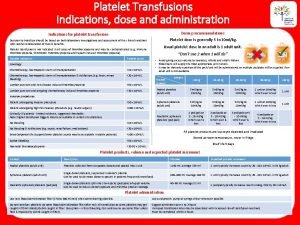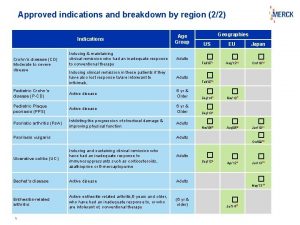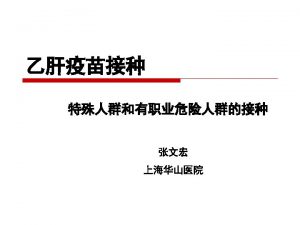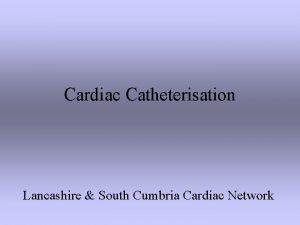CENTRAL VENOUS CATHETERISATION INDICATIONS Measurement of central venous





















- Slides: 21

CENTRAL VENOUS CATHETERISATION

INDICATIONS �Measurement of central venous pressure (CVP) ( E. G. those with hypotension not responding to normal management, requiring infusion of inotropes) �For long term administration of drugs for pain, infection, cancer or to supply nutrition. �Venous access for IV fluids or antibiotics or a peripheral site is unavailable/unaccessible �Haemodialysis

CONTRAINDICATIONS � Patients undergoing thrombolytic or anticoagulative therapy � Bleeding disorders � Vasculitis � Distorted local anatomy � Overlying skin infections( dermatitis), burns � Uncooperative patient

COMPLICATIONS INFECTIOUS Sepsis (also septic arthritis, osteomyelitis) • VASCULAR Air embolism, blood clot, hematoma, arterial puncture • • OTHERS PNEUMOTHORAX, hemothorax, arrhythmias , nerve injury

LOCATIONS of CVC � INTERNAL JUGULAR VEIN � SUBCLAVIAN VEIN � FEMORAL VEIN Length of catheters Ø 15 cm catheters for subclavian and internal jugular lines, and 60 cm catheters for femoral line

EQUIPMENT USED: � � � Patient on a tilting bed, trolley or operating table Standard multiple lumen kit Guide wire Sterile gloves Sterile gown Drapes Disinfectant (Povidone-iodine solution/ chlorhexidine) Suturing needle Scalpel Local Anaesthetic (lidocaine) Sterile saline flush

Triple lumen catheter Dilator A= small syringe and vial of 1% Lidocaine (L. A) B= guide needle C= IV syringe with catheter attached- D E= Disinfectant sponge Guidewire: J-shaped tip to reduce risk of vessel perforation

TECHNIQUE �SELDINGER 1) 2) 3) 4) 5) 6) TECHNIQUE (most common) Use guide needle to locate the vein Wire threaded through needle Remove needle A dilator is passed over the guide wire Dilator is removed and catheter is passed over wire and wire is removed Catheter secured in place Allows larger catheters to be placed in the vein after the passage of appropriate dilators along the wire and a small incision in the skin at the point of entry.


GENERAL PRINCIPLES Ø Obtain informed consent and explain risks and benefits of procedure Ø Optimal patient positioning and cooperation, make sure patient is comfortable Ø Take your time Ø Sterile technique Ø Local anaesthetic should be used Ø Always have a hand on your wire Ø Aspirate while advancing as you withdraw the needle slowly Ø Withdraw needle to the level of the skin before redirecting the angle Ø Don’t poke yourself with the needle Ø The tip of the catheter can lie in either the superior or inferior vena cava (SVC or IVC) or into the right atrium (RA).

INTERNAL JUGULAR APPROACH POSTIONING : TRENDELENBURG POSITION Ø Patient supine on surface inclined 45 degrees, head at the lower end and legs flexed over upper end. ( This distends the central veins and prevents air embolism) Ø Head turned to opposite side of central venous line Ø Stand at the head of the patient 1.

LOCATING AND ACCESSING VEIN Ø Ultrasound and landmarks can be used Ø IJV is between the clavicular and sternal heads of the sternocleidomastiod muscle Ø Point of needle insertion is midway between sternal head of SCM and mastoid process behind ear

PROCEDURE Ø Disinfect area , apply L. A and fenestrated drape Ø Place three fingers on carotid artery Ø Place needle about 45 degrees to the skin, lateral to the carotid artery Ø Direct needle in sagittal plane angled towards feet Ø Vein should be 1 -1. 5 cm deep, avoid deep probing in the neck Ø Seldinger technique used http: //www. youtube. com/watch? v=QHiu. Yc 22 pf. E

1. Disinfection, L. A and sterile drape 4. Place wire through needle and remove needle 2. Insert needle into IJV and aspirate 5. Insert catheter over wire then remove wire 3. Hold tip of needle with one hand 6. Once catheter is in place , secure and apply dressing

SUBCLAVIAN APPROACH POSITIONING Ø Trendelenburg postion (10 -15 degrees) Ø Supine position, head and shoulders neutral with arm slightly abducted Ø Stand beside the patient at the side PROCEDURE Ø Disinfect area and apply local anaesthetic Ø Cover procedure area with fenestrated sterile drape Ø Use seldinger technique LOCATION AND ACCESS TO VEIN Ø Identify the midclavicular point and sternal notch Ø Insert needle into the skin 1 cm below and lateral to the midclavicular point Ø Direction of needle should be parallel to skin Ø Advance posterior to the clavicle aiming for the sternal notch (Do not pass the needle further than the sternal head of the clavicle)

Location and insertion of needle http: //video. google. com/videoplay? docid=242132498694841858 2#

FEMORAL VEIN APPROACH POSITIONING Ø Ø Supine patient Extend the patient’s leg and abduct slightly at the hip PROCEDURE Ø Ø Ø Disinfect area and apply local anaesthetic Cover procedure area with fenestrated sterile drape Use seldinger technique LOCALISATION AND ACCESS TO VEIN Vein is medial to femoral artery Identify the pulsation of the femoral artery 1 -2 cm below the inguinal ligament. Ø Position needle at 45 degree angle and about 1 cm medial to pulsation Ø Needle inserted at skin about 2 cm below inguinal ligament Ø Aiming towards the umbilicus (In adults, the vein normally found 2 -4 cm from the skin. In small children reduce elevation on the needle to 10 -15° as the vein is more superficial) Ø Ø

http: //www. 4 shared. com/file/61538831/b 1027127/Placement_of_a_Fe moral_Venous_. html

POST CATHETER PLACEMENT 1) 2) 3) 4) 5) 6) 7) Aspirate blood from each port Flush with saline / sterile water Secure the catheter with sutures Apply sterile dressing Dispose of used gloves, needles, syringe etc Wash hands Chest x-ray for IJ and SC lines

EVALUATION LOCATION BENEFITS RISKS INTERNAL JUGULAR VEIN • Bleeding can be seen and controlled • Decreased risk of pneumothorax • Risk of Carotid artery puncture • Pneumothorax SUBCLAVIAN VEIN • Most comfortable for concious patients • Increased risk of pneumothorax • Should not be done on less than 2 yrs • Vein is noncompressible FEMORAL VEIN • Easy to locate • Less bad complications • No risk of pneumothorax • Preffered in emergencies • Highest risk of infection • Risk of DVT

THANX FOR LISTENING!
 Most common complication of central venous catheter
Most common complication of central venous catheter Central venous pressure monitoring for nurses
Central venous pressure monitoring for nurses Central venous acess
Central venous acess Cvp waveforms
Cvp waveforms Central venous lines
Central venous lines Groshung
Groshung Rubeosis of iris
Rubeosis of iris Jugular venous pulse waves
Jugular venous pulse waves Venous beading meaning
Venous beading meaning Five layers of scalp
Five layers of scalp Vertical
Vertical Venous loop
Venous loop Apical group of axillary lymph nodes
Apical group of axillary lymph nodes Narrowest part of oesophagus
Narrowest part of oesophagus Equinus deformity in varicose veins
Equinus deformity in varicose veins Venous reserve
Venous reserve What is arteriolar tone
What is arteriolar tone Spinal cord venous drainage
Spinal cord venous drainage Posterior arch vein
Posterior arch vein Blood supply to the stomach
Blood supply to the stomach Virchow's triad definition
Virchow's triad definition Dural arterial supply
Dural arterial supply


